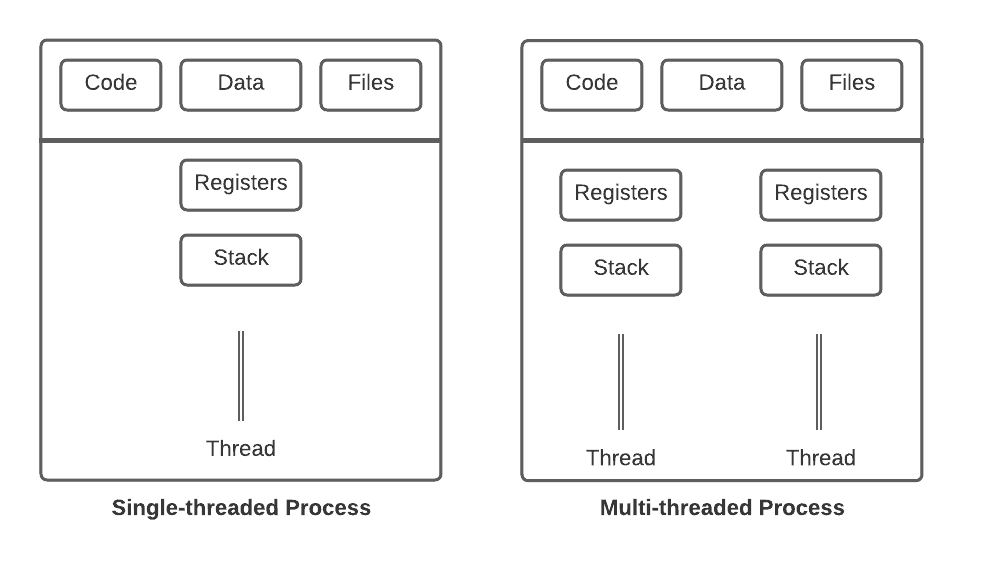1. 概述
在并发编程中,进程(Process)与线程(Thread)是两个最基本也是最容易混淆的概念。本文将从定义、特性、差异等多个维度对两者进行对比分析,并结合实际开发中的优缺点进行总结,帮助读者更清晰地理解它们在系统设计和并发编程中的作用。
2. 基本定义
✅ 进程(Process)
进程是程序的一次执行过程。它包含了程序代码、数据、资源(如打开的文件)、以及操作系统维护的执行状态信息(如进程间关系)。操作系统通过系统调用(system call)来创建、调度和终止进程。
进程是资源分配的基本单位。每个进程都有独立的地址空间和资源,彼此之间互不干扰。
✅ 线程(Thread)
线程是轻量级的执行单元,可以看作是“半进程”。每个线程拥有自己的栈空间,但与其他线程共享同一块内存空间(包括代码段、数据段和堆内存)。
线程是CPU调度的基本单位。多个线程可以并发执行,共享同一进程的资源,通信也更加高效。
✅ 线程的实现方式
- 内核级线程(Kernel-level Thread):由操作系统直接管理,调度开销大,但支持真正的并发。
- 用户级线程(User-level Thread):由线程库在用户空间管理,创建和切换快,但无法利用多核CPU。
- 混合线程(Hybrid Thread):结合上述两种方式,如 Java 的线程模型就是基于操作系统线程实现的。
3. 进程与线程的差异
虽然线程和进程在某些方面有相似之处,但它们在内存管理、通信机制、创建和销毁成本等方面存在显著差异。
3.1 进程的特点
- 独立性强:每个进程拥有独立的内存空间,数据不共享,互不干扰。
- 创建成本高:需要多次系统调用(如 fork、exec)来创建。
- 通信复杂:进程间通信(IPC)需要借助额外机制(如管道、共享内存、消息队列等),增加了系统调用次数。
- 资源消耗高:由于每个进程都有独立的资源,因此占用内存和CPU资源更多。
3.2 线程的特点
- 共享性强:同一进程下的线程共享内存空间(如全局变量、堆内存)。
- 创建成本低:只需一次系统调用即可创建多个线程。
- 通信简单:无需额外机制,直接访问共享内存即可通信。
- 资源消耗低:线程共享资源,内存占用更少。
3.3 进程 vs 线程对比表
| 对比维度 | 进程(Process) | 线程(Thread) |
|---|---|---|
| 定义 | 程序的一次执行 | 半进程,轻量级执行单元 |
| 创建 | 多次系统调用 | 一次系统调用 |
| 销毁 | 耗时较长 | 耗时较短 |
| 通信 | 需要 IPC 机制 | 直接共享内存 |
| 上下文切换 | 较慢 | 较快 |
| 资源占用 | 高(独立内存) | 低(共享内存) |
| 数据共享 | 需要额外机制 | 默认共享 |
| 安全性 | 高(隔离) | 低(相互影响) |
4. 使用线程 vs 进程的优缺点分析
✅ 线程组(Thread Group)的优势
线程组是指运行在同一个进程中的多个线程。它们共享内存、全局变量、文件描述符和堆内存。
优势:
- 并行性强:多个线程可并行处理任务,提高程序响应速度。例如,一个线程处理数据库查询,另一个线程处理UI交互。
- 上下文切换快:线程间的切换比进程快,因为它们共享内存空间。
- 通信简单高效:线程间可以直接通过共享内存通信,无需额外机制。
劣势:
- 资源共享风险:一个线程出错可能影响整个进程中的其他线程。
- 缺乏隔离性:没有进程那样的保护机制,线程崩溃可能导致整个进程崩溃。
- 不可跨机器运行:线程必须在同一台机器上运行,而进程可以分布到不同机器上。
✅ 进程组(Process Group)的优势
- 隔离性强:操作系统会保护各个进程,即使一个进程崩溃,也不会影响其他进程。
- 资源独立:各自拥有独立的内存空间,避免数据冲突。
- 可分布式部署:适合在不同机器上运行,适合构建分布式系统。
劣势:
- 创建销毁成本高
- 通信复杂,需要IPC机制
- 上下文切换慢
如下图所示,线程和进程在结构和资源使用上的差异:

5. 总结
- 进程是资源分配的基本单位,具有独立性、安全性高,但资源消耗大、通信复杂。
- 线程是调度的基本单位,轻量级、通信简单、切换快,但共享资源也带来了安全风险。
- 在实际开发中,线程更适合处理并发任务,如网络请求、UI响应等;而进程更适合需要隔离性和分布式部署的场景,如服务容器、微服务架构。
✅ 开发建议:
- 对性能敏感、任务并发度高的场景优先使用线程。
- 对稳定性、隔离性要求高的系统建议使用进程。
- 线程使用时要注意线程安全问题,避免共享数据导致的并发 bug。
- 多进程架构适合构建健壮性强、可扩展的分布式系统。
⚠️ 踩坑提醒:
- 不要随意创建大量线程,容易造成资源耗尽或上下文切换频繁。
- 线程间共享资源时,务必做好同步控制(如使用 synchronized、ReentrantLock 等)。
- 进程间通信要避免频繁的 IPC 调用,否则影响性能。
通过合理选择进程和线程,可以在不同场景下实现性能与稳定性的最佳平衡。